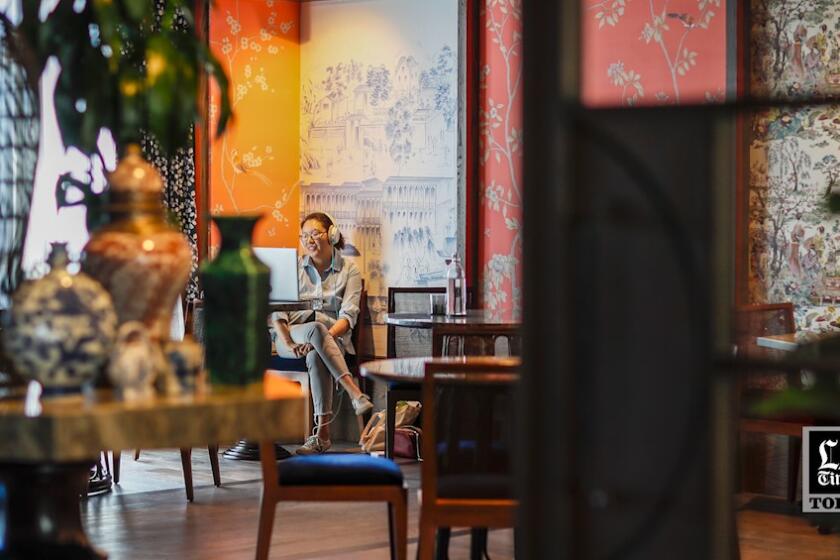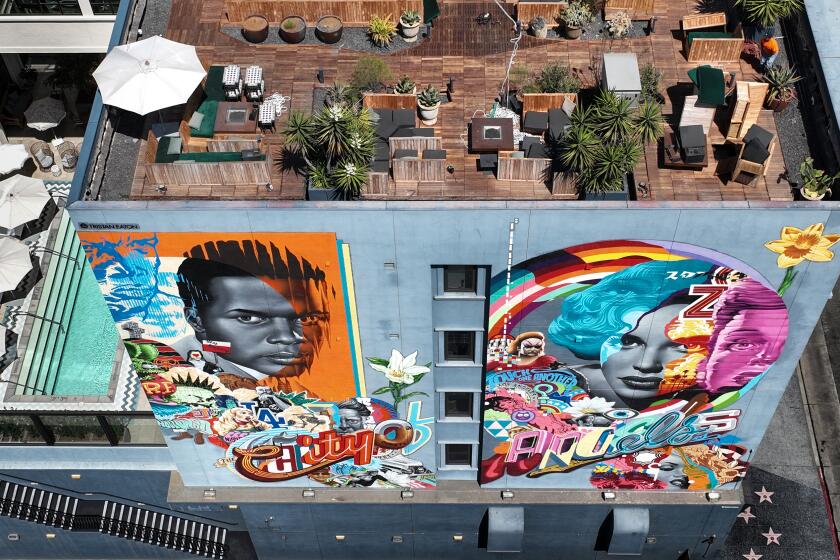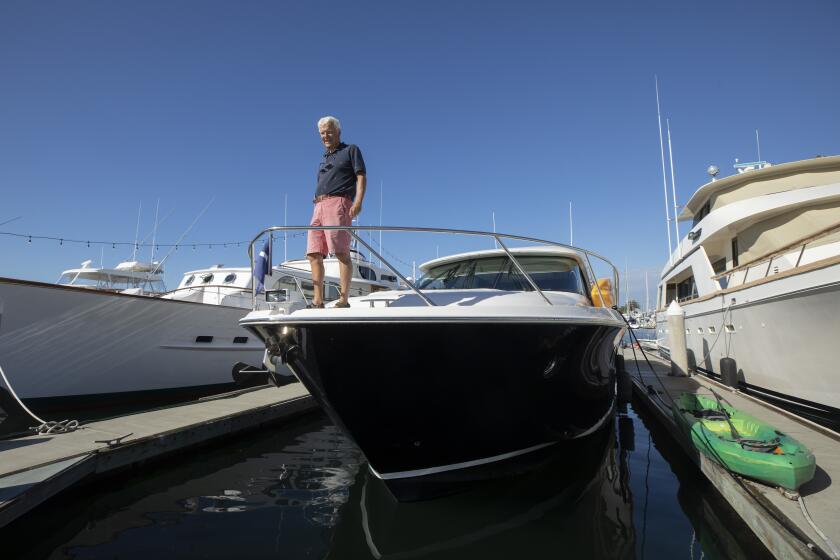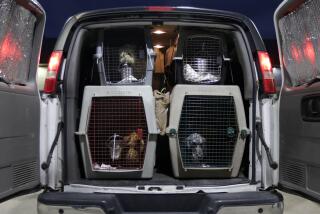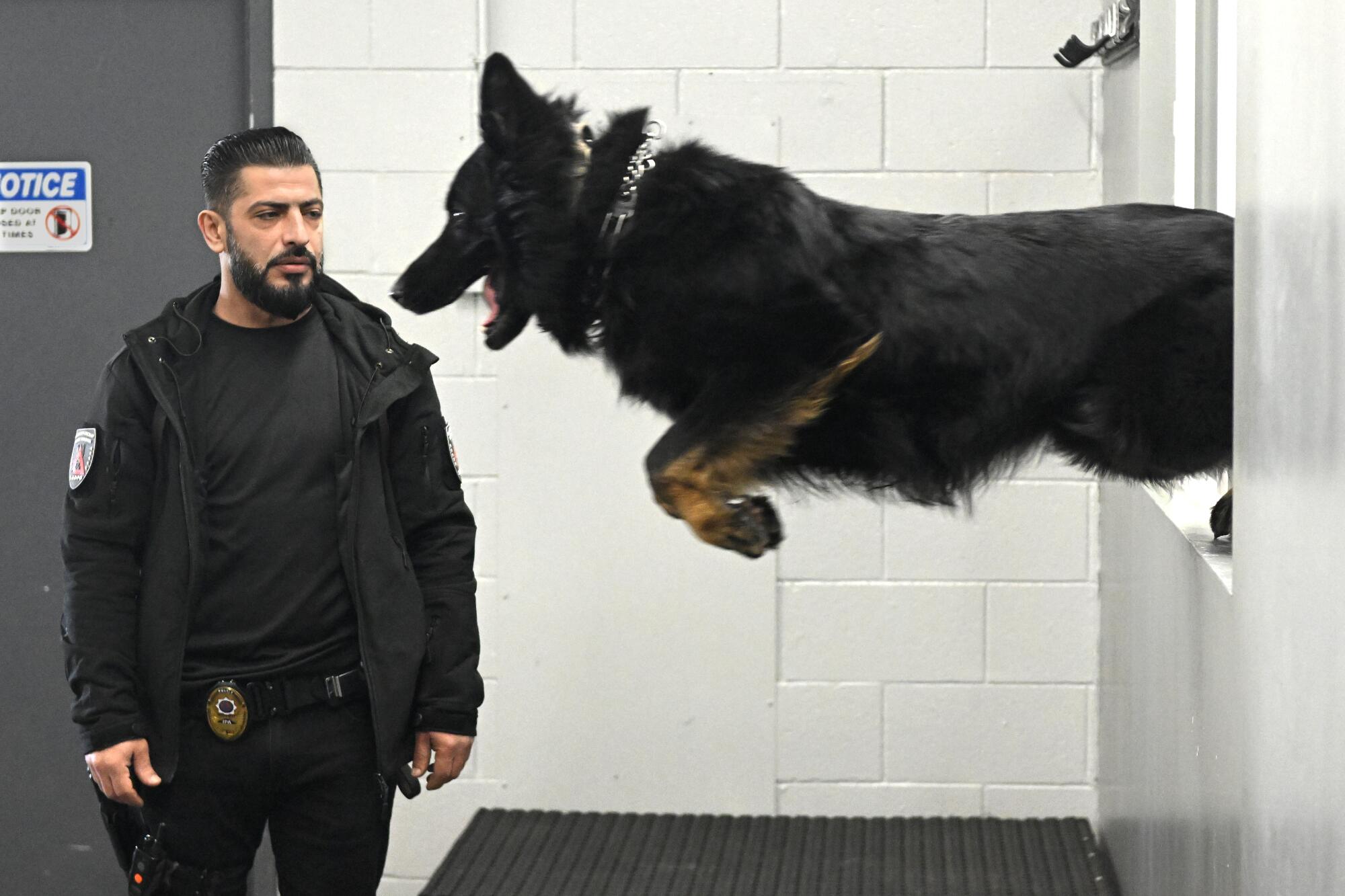
- Share via
Before Arteom Bulgadarian bought his Sherman Oaks home, it belonged to baseball star Yasiel Puig, who was burglarized of $170,000 worth of jewelry and other items while he was out of town.
So Bulgadarian, 44, has been vigilant about security since moving in, especially with three young children and a job running an aerospace manufacturing company that often necessitates late nights at the office. He owns several guns and has equipped his nearly 5,000-square-foot, six-bedroom house, set behind an iron gate, with surveillance cameras and an alarm system. A neighborhood watch group patrols the area around the clock.
And then there’s Rocky.
Nothing gives Bulgadarian peace of mind like his 2½-year-old German shepherd, which was bred, selected and trained to be a high-performance protection dog. Unlike a police or military canine, a protection dog is a family pet first and foremost, but one that is prepared to attack an assailant, if necessary, while guarding a home or when out in public with its owner.
Bulgadarian bought Rocky as a puppy from Delta K9 Academy and signed him up for a rigorous training program at the company’s facility in North Hollywood, spending $70,000 — not uncommon for such top-of-the-line dogs.
“What’s the price that you would put for your family’s security, especially when that particular house has been burglarized?” he said. “Seventy-thousand dollars — you amortize it over 10 to 15 years, whatever the dog’s life is, and it’s not that big of a price tag.”

The elite animals — typically German shepherds, Belgian Malinois, Dobermans, cane corsos or a mix of those breeds — are marketed under names such as “personal canine bodyguards” and “executive protection dogs.” Amid a spate of high-profile crimes in upscale parts of Los Angeles, they have become highly sought after among the rich, many of whom worry about being targeted.
Protection dogs, they say, provide an immediate layer of front-line defense, unlike security cameras (which merely show an intruder on the property, and only if the devices happen to be pointed in the right direction) and home alarm systems (which can be bypassed or ignored). Even if police are summoned, they can be slow to respond, if at all. So homeowners who can afford it are being more proactive.
“Every celebrity client, at one time or another, and billionaire has said to me these exact words: ‘What about a dog?’” said Kris Herzog, owner of the Bodyguard Group of Beverly Hills. They’re status symbols and over time can even be cost saving: “People don’t want to pay $400 an hour for two off-duty police officers.”
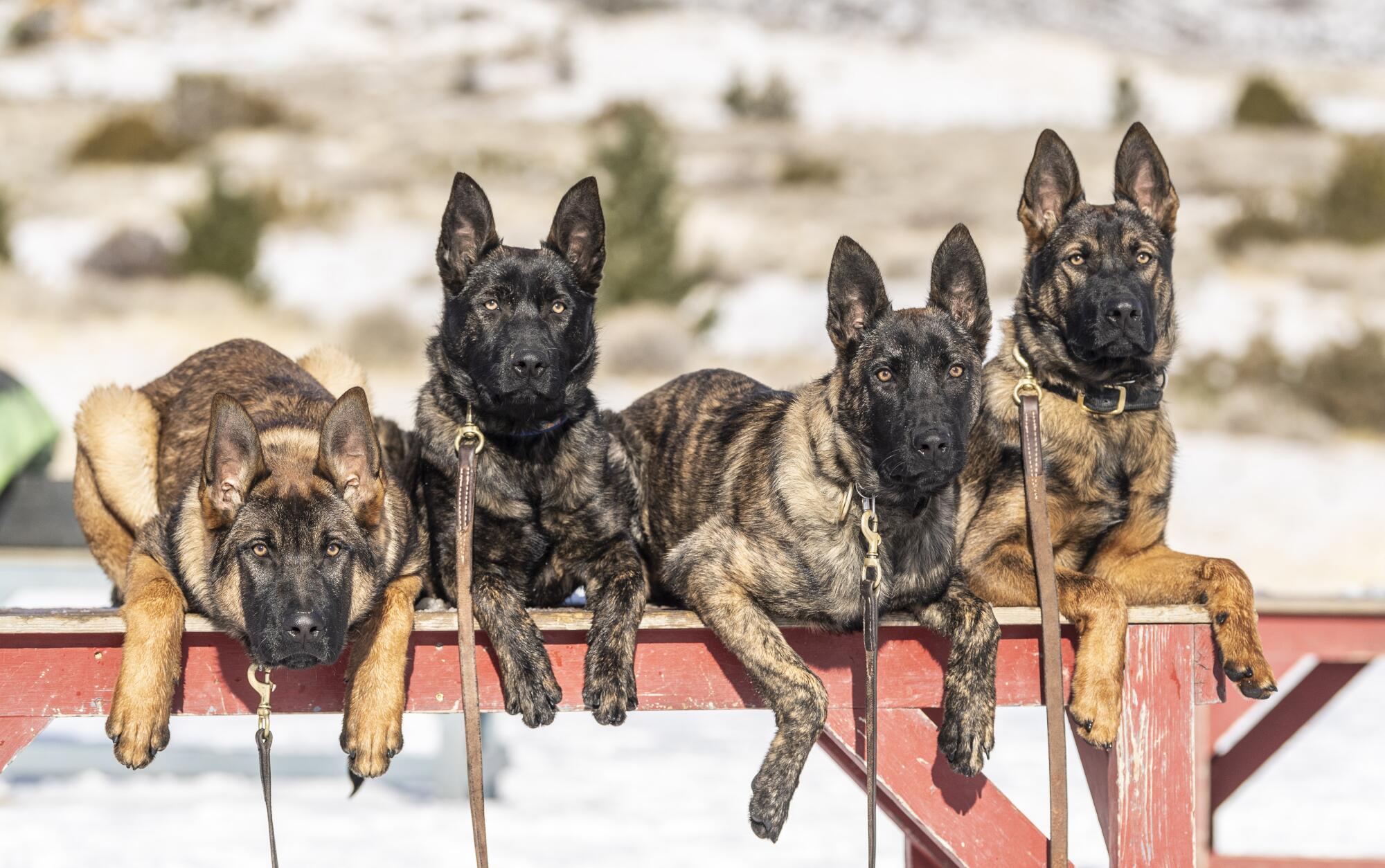
Herzog’s firm links customers with various security service providers, including canine trainers who sell trained guard dogs for $55,000. “A dog is always my recommendation if you’re not going to have a gun in the house,” he said.
Describing a feeling of growing lawlessness, affluent Angelenos point to double-digit increases in burglaries and property crime, smash-and-grab thefts at high-end stores and brazen “follow-home” robberies (in which wealthy people are tailed from restaurants, bars and boutiques and then robbed by armed thieves). Two protection dog brokers said the murder of Jacqueline Avant in her Beverly Hills home in 2021 led to a spike in inquiries.
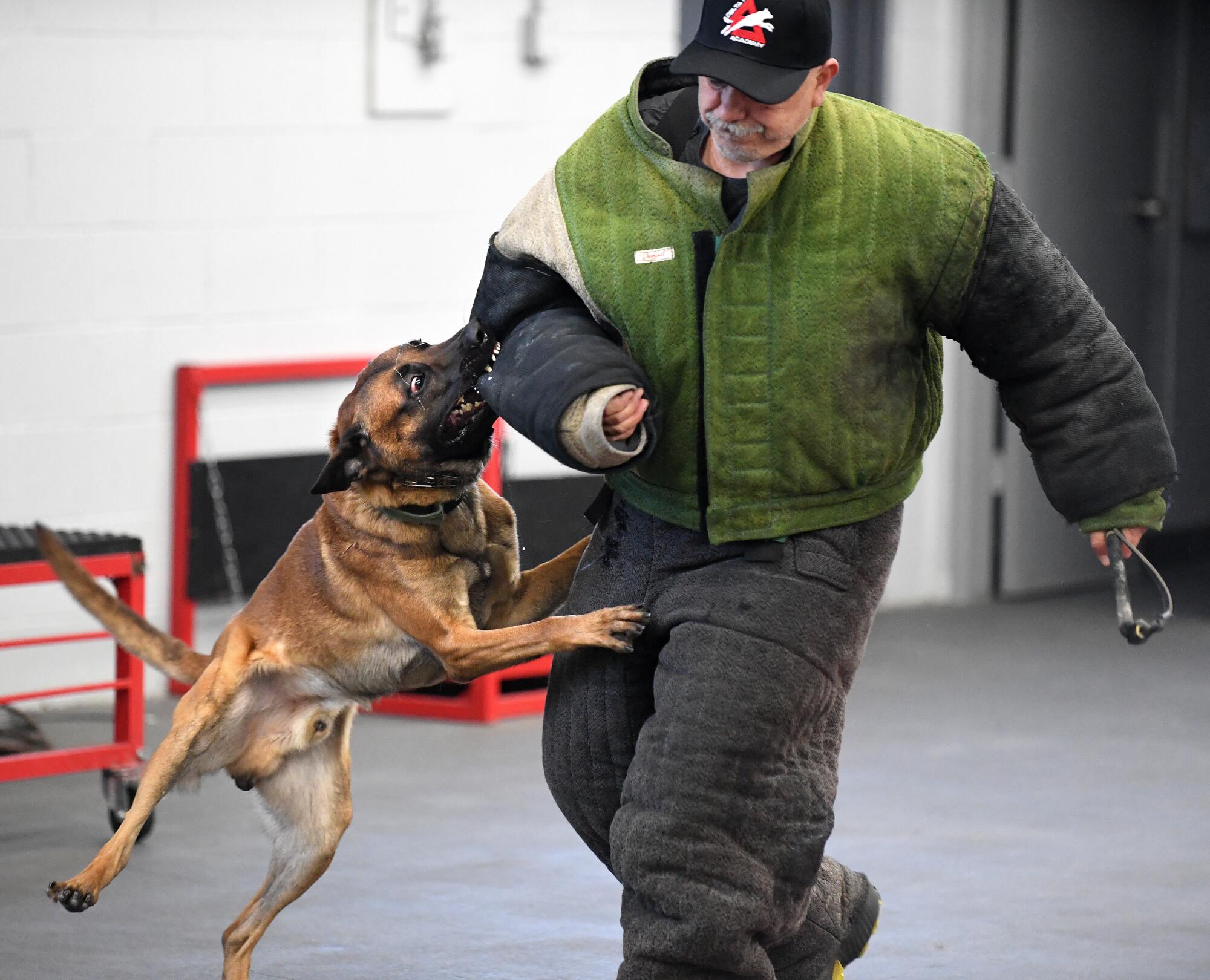
Luxury real estate agent Branden Williams said protection dogs have become so popular among his mega-wealthy clients in L.A. that he’s now in the market for one himself, especially after a neighbor was robbed at gunpoint in Beverly Hills. Williams has tasked the same broker his mom used to buy her protection dog, a German shepherd imported from Germany, with finding him a suitable animal this year.
“I will say they’re not cheap; the ones I’m looking at are between $60,000 and $100,000,” he said. “It’s a whole other level of training; we’re not talking about doggy day care here.”
These are good solid companions that take care of their family. They’re not trained to kill — we don’t train killers — they’re trained to stop the threat.
— November Holley, president of Harrison K-9 in South Carolina
Operating a protection dog business is a labor-intensive pursuit. Svalinn, a breeding and training company in Montana, employs 11 full-time staff members and produces no more than 18 adult protection dogs annually.
“To be very blunt, our dogs that were born in 2022 are being sold at a price of $150,000,” founder Kim Greene said. “It’s a coveted product.”
Training begins at Svalinn’s sprawling ranch when the puppies are 8 weeks old, with handlers working with them daily until they are ready to be placed in permanent homes.
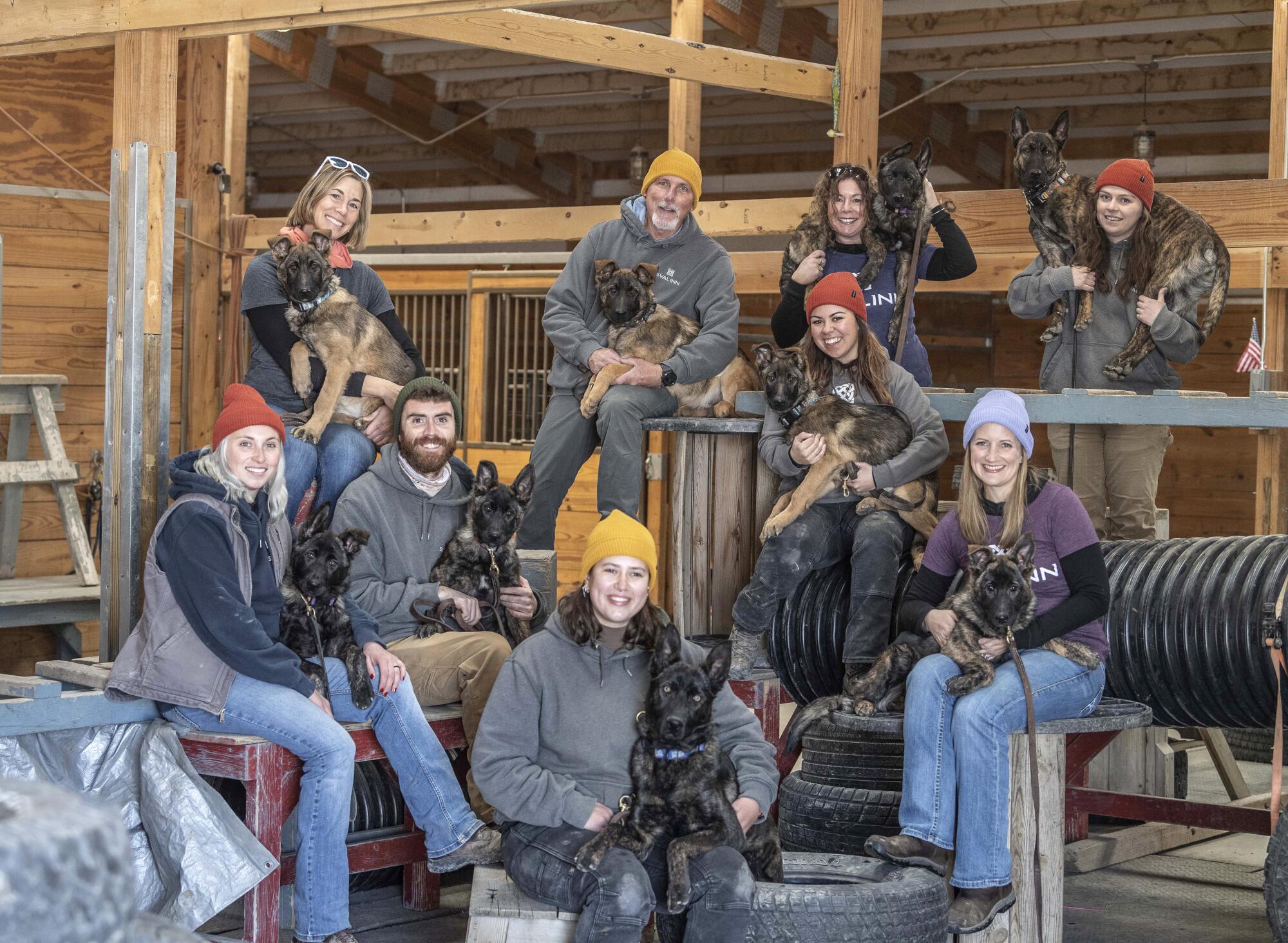
Four years ago, Greene charged $75,000 for one of her fully trained dogs, a crossbreed of German, Belgian and Dutch shepherds with distinctive black masks and a stern wolfy appearance. But soaring demand has allowed her to raise the price every year since.
“We’re taking deposits on puppies as young as 4 months of age for delivery two-plus years later,” she said. “We can’t create the assets quickly enough.”
Trainers say a common misconception is that such dogs are vicious and out of control. Rather, the animals are bred for temperament (intelligence and stability are key) and taught to be compliant and calm under pressure. The goal is an adaptable, even-keeled animal that can accompany and defend its owner anywhere.
“These are good solid companions that take care of their family,” said November Holley, president of Harrison K-9, which imports German shepherds from Germany and trains them at its 25-acre compound in South Carolina. “They’re not trained to kill — we don’t train killers — they’re trained to stop the threat.”
Dog-bite-related fatalities are rare, estimated to total a few dozen a year in the U.S. Breeders, veterinarians and animal control officers stress that any dog can bite anyone, but a properly trained and well-socialized animal helps mitigate the risk. Roughly 4.5 million people are bitten by dogs annually, with children being the most common victims, the American Veterinary Medical Assn. said.
“It is a not a dog’s breed that determines whether it will bite, but rather the dog’s individual history and behavior,” the group said. “Most dog bites are preventable.”
When a protection dog is confronted with danger, Greene said, its first instinct should be to “create distance, space and time for you to move to safety.” That said, “if someone went to lay hands on you with malicious intent and you were scared for your life, that dog will respond in force.”
At Harrison K-9, protection dogs are usually sold for $45,000 to $65,000, although a special-order canine can run into the six figures depending on bloodline, color, country of origin, titles and special training requests; its highest-priced dog ever was purchased by a Minnesota business executive for $230,000. In business since 1975, it last year sold 65 protection dogs, a company record.
Secretive members clubs became even more in demand during the pandemic with their promise of a full-lifestyle day-to-night experience that combines co-working and socializing under one stylish roof.
“They’re in Miami, they’re on yachts, they’re in the Caribbean, they’re in Canada, they’re in Thailand,” Holley said. Harrison K-9’s extremely niche client base is in the “upper 3[%] to 4% financially” and includes professional athletes, business moguls, Oscar-winning actors, A-list celebrity couples “and the traditional affluent family.”
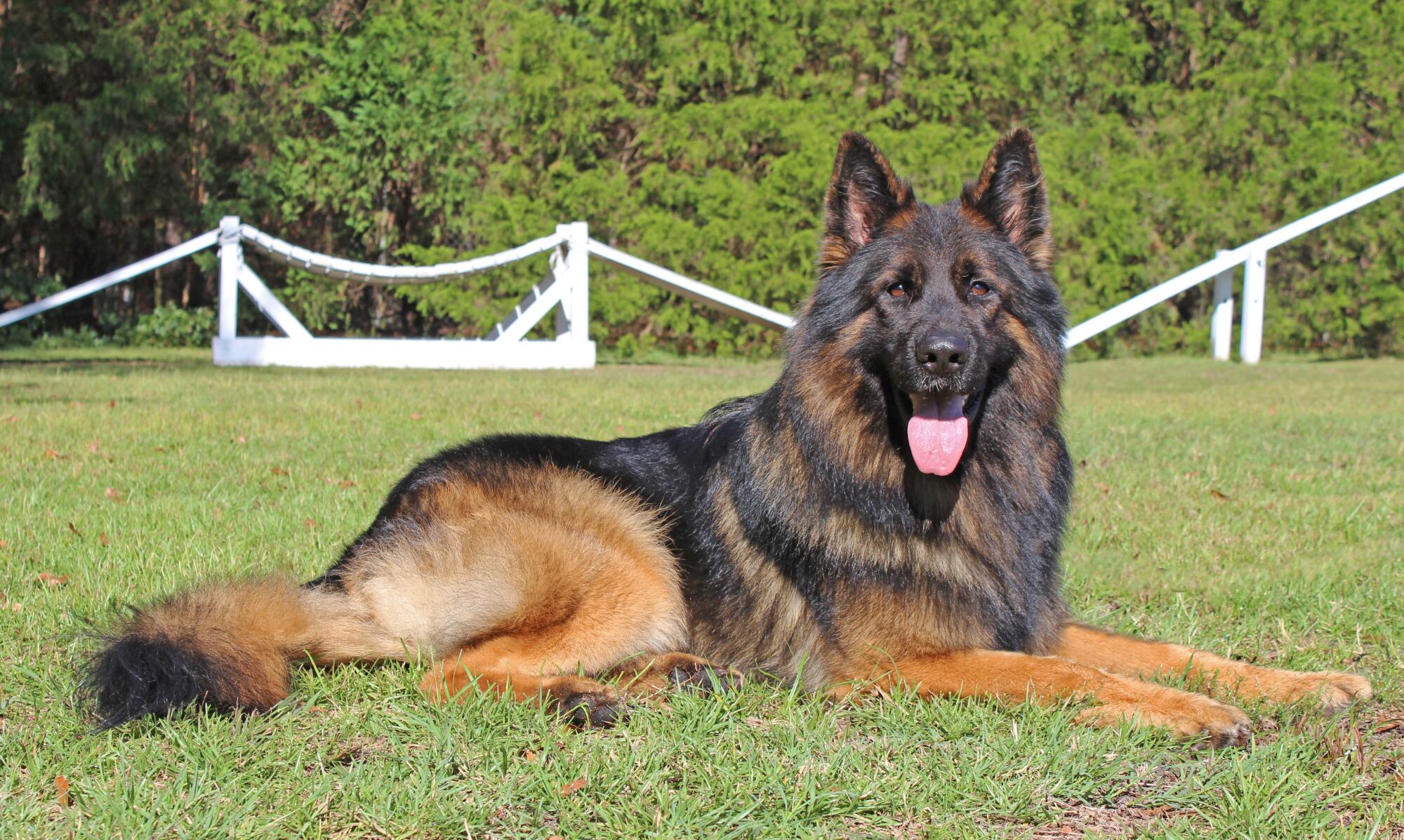
There is no standard industry playbook or official certification — some companies sell ready-to-go adult dogs only, while others prefer to bring customers in on joint lessons from the start — but in general, training regimens are mentally and physically intense.
The dogs are taught obedience and attack commands, sometimes in another language to mask what their owners are saying, and taken to different environments including homes, retail stores, restaurants and office buildings to expose them to large numbers of people and scenarios in real-world settings. Training is also tailored to each family’s unique needs.
“Let’s say you own a yacht. You need a dog that’s comfortable on a boat,” Holley said. “We listen to the client and try to mimic their lifestyle.”
At Delta K9 Academy, where Bulgadarian purchased Rocky, owner Mike Israeli offers four tiers of training. The company’s highest-level protection dogs learn how to show aggression (baring their teeth, snarling and barking); execute bite-and-hold maneuvers on different parts of the body; fight an attacker who is wielding a weapon; refuse food given by a stranger (to prevent poisoning); and jump in and out of vehicles.
A fully trained protection dog is like a weapon.
— Mike Israeli, owner of Delta K9 Academy
“People understand the value,” Israeli, 38, said. “Hiring a bodyguard yearly, the salary is $150,000 and they’re not with you 24/7 — and they’re not as loyal.”
Many protection dog companies include in-home visits during the first few days after a dog is delivered to help it acclimate to new surroundings and bond with its family, and to properly introduce it to children and pets. Owners are liable if their dogs, protection-grade or not, accidentally injure someone, so routine maintenance training is recommended to ensure the animals’ skills remain sharp.
“A fully trained protection dog is like a weapon,” Israeli said during a recent visit to Delta K9 Academy’s headquarters, his shaggy 6-year-old German shepherd, Graff, looming in a corner. “If you don’t know how to use it, you can hurt yourself or someone else. So we make sure that you’re fully in control.”
Yacht brokers say demand is through the roof, with little to no inventory and multi-month wait lists.
To demonstrate, Israeli led Graff toward a training room, where one of the company’s employees was wearing a thickly padded $1,600 bite suit and concealed from view on an elevated platform. On cue, the dog leaped through a 4-foot-high open window, zeroed in on the corner where the person was hiding, scaled a towering stack of metal boxes and dragged the man, now yelling and thrashing about, to the ground.
With his teeth clamped firmly on the aggressor’s arm, the burly, nearly all-black shepherd hung on as he was swung around in circles, all four paws in the air as the two struggled. As soon as Israeli called out the release command, Graff let go and trotted back to his side, panting but otherwise seeming unbothered.
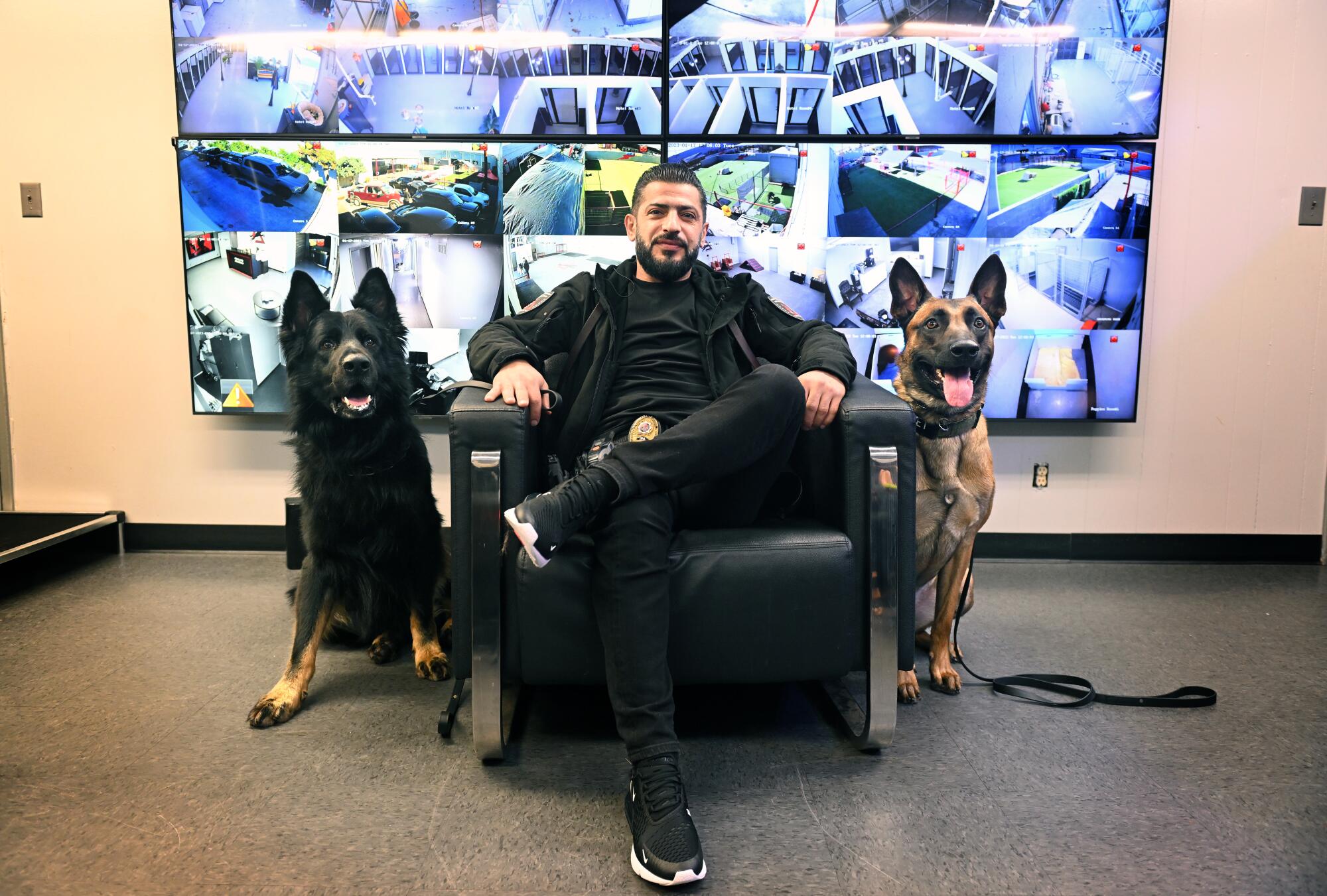
Although protection dogs are rarely deployed by their owners, their intimidating presence alone provides a “psychological deterrent to the bad guys,” Holley said.
“It’s like, ‘Hey, this could be an ordeal, this could hurt.’ And that makes people stay away,” she said. “Honestly, most people have an inherent fear of being eaten by an animal.”
That’s the reaction that Tammy Parkinson, 47, was going for when she purchased a German shepherd puppy named Koda from Israeli last year; they now attend his protection dog training classes together on Monday and Thursday nights.
“Just with everything going on, I wasn’t feeling extremely safe,” she said. Her fiance travels weekly for work, leaving her alone in their house in Shadow Hills, a quaint semirural neighborhood in the San Fernando Valley. “It doesn’t matter where you live anymore. I’m not going to be a victim.”
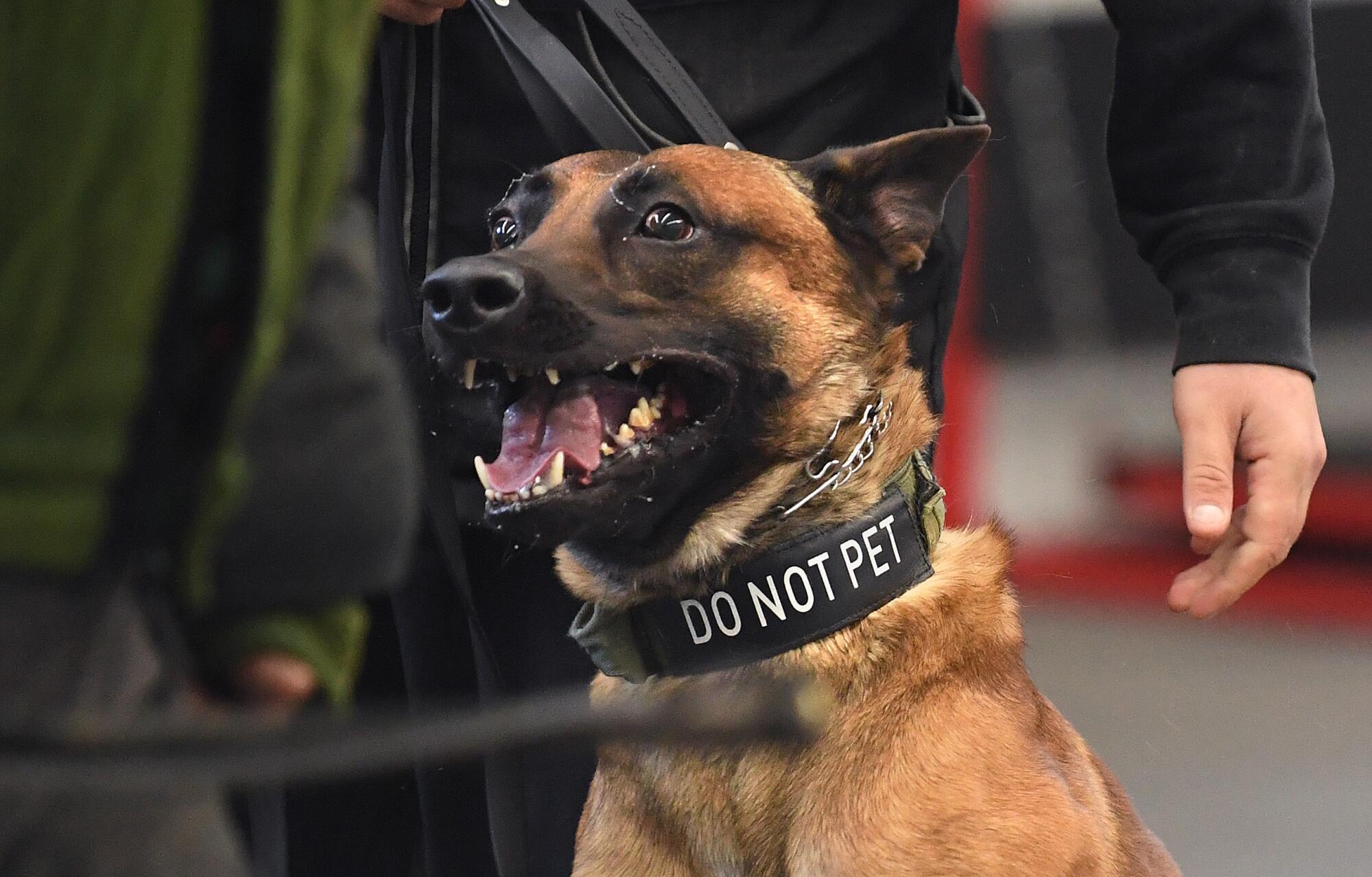
Parkinson, an accountant, said she worries that crime is worsening and not much is being done about it. Through Dec. 24, burglaries rose 12.5% in Los Angeles last year compared with the same time frame in 2021, according to preliminary crime statistics released by the LAPD. Property crimes increased about 10% and robberies were up 7%. After a surge during the first two years of the COVID-19 pandemic, violent crime rose less than 1%.
“The criminals have more rights than we do,” Parkinson said. “They’re just being released left and right; there’s no consequences. So I’m like, you know what, it’s better at this point to have the protection dog in case something was to happen. Trust me, they’re gonna want the dog bite rather than the gunshot.”
Bulgadarian has been so pleased with Rocky that he bought a second dog, Duman, from Israeli a few months ago and signed her up for protection training too.
“My neighbors love it,” he said. “I even got an offer: ‘Let’s make a hole so they can go to our yard as well.’”
More to Read
Inside the business of entertainment
The Wide Shot brings you news, analysis and insights on everything from streaming wars to production — and what it all means for the future.
You may occasionally receive promotional content from the Los Angeles Times.

